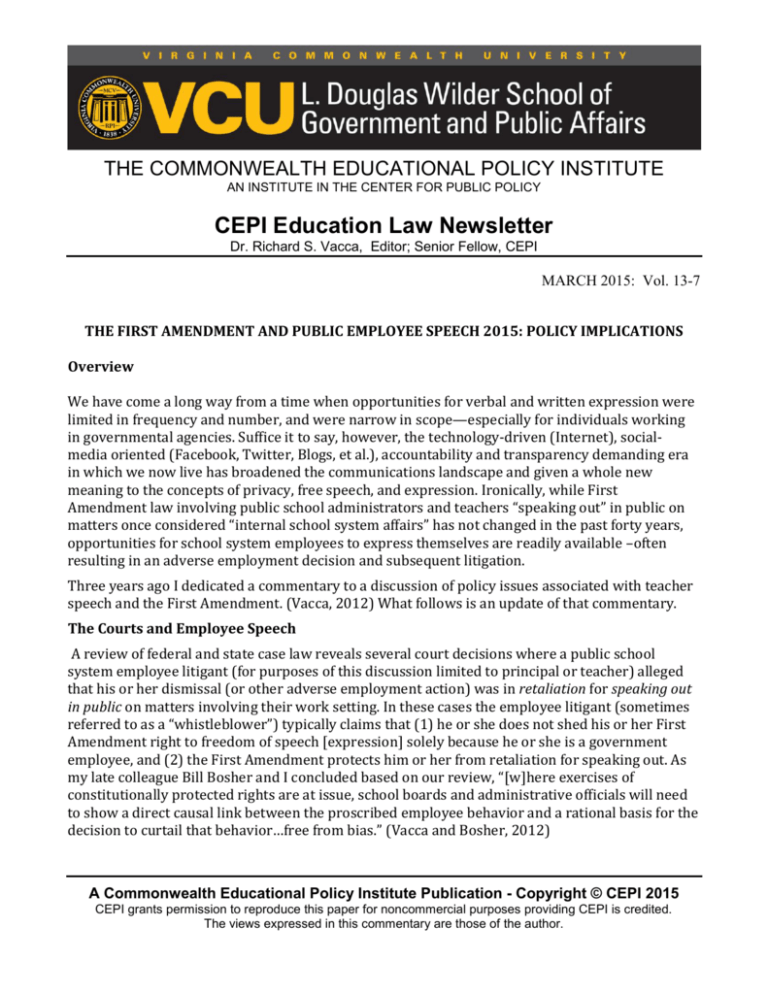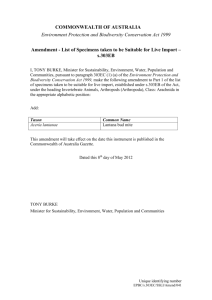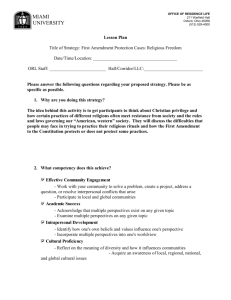March 2015: The First Amendment and Public Employee Speech
advertisement

THE COMMONWEALTH EDUCATIONAL POLICY INSTITUTE AN INSTITUTE IN THE CENTER FOR PUBLIC POLICY CEPI Education Law Newsletter Dr. Richard S. Vacca, Editor; Senior Fellow, CEPI MARCH 2015: Vol. 13-7 THE FIRST AMENDMENT AND PUBLIC EMPLOYEE SPEECH 2015: POLICY IMPLICATIONS Overview We have come a long way from a time when opportunities for verbal and written expression were limited in frequency and number, and were narrow in scope—especially for individuals working in governmental agencies. Suffice it to say, however, the technology-driven (Internet), socialmedia oriented (Facebook, Twitter, Blogs, et al.), accountability and transparency demanding era in which we now live has broadened the communications landscape and given a whole new meaning to the concepts of privacy, free speech, and expression. Ironically, while First Amendment law involving public school administrators and teachers “speaking out” in public on matters once considered “internal school system affairs” has not changed in the past forty years, opportunities for school system employees to express themselves are readily available –often resulting in an adverse employment decision and subsequent litigation. Three years ago I dedicated a commentary to a discussion of policy issues associated with teacher speech and the First Amendment. (Vacca, 2012) What follows is an update of that commentary. The Courts and Employee Speech A review of federal and state case law reveals several court decisions where a public school system employee litigant (for purposes of this discussion limited to principal or teacher) alleged that his or her dismissal (or other adverse employment action) was in retaliation for speaking out in public on matters involving their work setting. In these cases the employee litigant (sometimes referred to as a “whistleblower”) typically claims that (1) he or she does not shed his or her First Amendment right to freedom of speech [expression] solely because he or she is a government employee, and (2) the First Amendment protects him or her from retaliation for speaking out. As my late colleague Bill Bosher and I concluded based on our review, “[w]here exercises of constitutionally protected rights are at issue, school boards and administrative officials will need to show a direct causal link between the proscribed employee behavior and a rational basis for the decision to curtail that behavior…free from bias.” (Vacca and Bosher, 2012) A Commonwealth Educational Policy Institute Publication - Copyright © CEPI 2015 CEPI grants permission to reproduce this paper for noncommercial purposes providing CEPI is credited. The views expressed in this commentary are those of the author. THE COMMONWEALTH EDUCATIONAL POLICY INSTITUTE - Education Law Newsletter Traditional First Amendment Judicial Standard of Analysis. In Pickering v. Board of Education (1968), the United States Supreme Court held that while school officials maintain their authority and interest in the effective and efficient operation and administration of the school system, a public school employee does not surrender his or her First Amendment right to comment on “matters of public interest” solely because he/she is a government employee—a balance of the two interests is needed. One year later in Tinker v. Des Moines (1969), a landmark student First Amendment speech case, the United States Supreme Court further clarified that “First Amendment rights, applied in the special characteristics of the school environment, are available to teachers and students….” The Court stated that absent facts “which might reasonably have led school authorities to forecast substantial disruption of or material interference with school activities,” First Amendment protections of free expression prevail over school system disciplinary actions. Expanded Judicial Analysis. Almost four decades ago, in Mt. Healthy v. Doyle (1977), a case involving the non-renewal of a non-tenured teacher and allegations of First Amendment freedom of speech and Fourteenth Amendment due process violations, the United States Supreme Court established a judicial standard that has had a major impact in balancing the prerogatives of public school officials in matters of personnel decision-making with the constitutional and statutory rights and protections of employees. (Vacca and Bosher, 2012) The standard of judicial analysis set in place by Chief Justice Rehnquist poses the following questions: (1) Is there present in this situation some element or exercise of constitutionally or statutorily protected conduct? (2) Did this element or exercise play a “substantial or motivating part” in the board’s decision regarding this employee? (3) Absent elements (1) and (2), would the board have made the same decision regarding this employee—as demonstrated by a preponderance of the evidence? In Chief Justice Rehnquist’s view, the three-pronged standard would have two primary effects: (1) it would strike a balance between the interest and protections of the employee as “citizen” with the interest of the employer to carry out its legal responsibilities, and (2) it would help to “distinguish between a result caused by a constitutional violation and one not so caused.” (Mt. Healthy, 1977) Subsequent case law established that to trigger the analysis, plaintiff employee bears the initial burden to show that his/her conduct satisfied both prongs (1) and (2) of the standard. If so, could the employer still show that it would have reached the same decision? See, e.g., Renfroe v. Kirkpatrick (N.D. Ala, 1982) In Connick v. Meyers (1983), a non-school related public employee First Amendment case, the Supreme Court admonished that “the First Amendment does not require a public office to be run as a roundtable for employee complaints over internal office affairs.” In this case the employer saw the employee’s inner office activities as “disruptive of office administration.” More recently the Supreme Court in Garcetti v. Ceballos (2006), created a difference between an employee speaking as a “citizen” on matters of “public concern” and an employee speaking as an “employee” on matters of “public concern.” In the Court’s view “the First Amendment does not prohibit 2|Page THE COMMONWEALTH EDUCATIONAL POLICY INSTITUTE - Education Law Newsletter managerial discipline based on an employee’s expressions made pursuant to official responsibilities.” Alexander and Alexander have linked Mt. Healthy (1977) with the Supreme Court’s benchmark decisions in Pickering v. Board of Education (1968), Connick v. Meyers (1983), and Garcetti v. Cabellos (2006) to demonstrate the creation, over time, of the following “five step” employee/First Amendment judicial inquiry. In this situation: (1) is the employee speaking pursuant to his official duties? If so there is no constitutional protection. If not pursuant of his official duties, (2) is the employee speaking as a “citizen” on a matter of “public concern?” If the employee is speaking as a” citizen on a matter of public concern,” (3) does the employee’s interest outweigh the interest of the state as employer? If the employee’s speech is protected, (4) the employee must show that his speech was “a substantial factor or motivating factor in a detrimental employment decision.” If the employee establishes by a preponderance of the evidence that his speech was such a factor, (5) can the employer “demonstrate that it would have taken the same action against the employee even in the absence of the protected speech? (Alexander and Alexander, 2012) Recently I came across a decision from the United States Court of Appeals for the Seventh Circuit—one that offers an excellent example of the application of the First Amendment/employee judicial analysis discussed above. An Illinois case, the Court’s rationale is instructive and has implications for local school system policy. McArdle v. Peoria School District No. 150 (7th Cir. 2013) Facts: In August, 2008, Julie McArdle (hereafter referred to as J.M.) was hired as a public middle school principal. Her contract was for two years but allowed the school district to terminate her after one year with severance pay. At that time the middle school’s prior principal Mary Davis (hereafter referred to as M.D.), served as the school district’s Academic Officer. This position made her J.M.’s superior. According to J.M. she began to discover irregularities in prior practices at the middle school which included M.D.’s use of school funds and a school credit card for personal purposes; her direction of payment to a student teacher in violation of school board policy; and her circumvention of rules regarding admission procedures for nonresident students. J.M. alleged that she questioned M.D. about some of these practices and received “evasive answers.” In January 2009, M.D. began allegedly attempting to discredit J.M. in her reports to the superintendent of schools, her evaluations of J.M., and her dealings with the PTO and other parents. J.M. continued to discover inconsistencies and financial irregularities. Subsequently, in February 2009, M.D. put J.M. on a “performance improvement plan.” J.M. asserted that M.D. cited parental complaints as part of the reason for the performance warning, but she would not identify those who complained. On April 21, 2009, the district’s director of human resources (T.B.) informed J.M. that the school board soon would be considering early termination of her contract. On April 23, 2009, J.M. consulted an attorney and filed a police report in which she 3|Page THE COMMONWEALTH EDUCATIONAL POLICY INSTITUTE - Education Law Newsletter accused M.D. of “theft of school funds.” She also sent an email to T.B. and the district superintendent (K.H.), and the school board’s vice president which listed improprieties and other misconduct by M.D. both as principal and in her new position. At an April 27, 2009, school board meeting K.H. recommended that J.M.’s contract be terminated at the end of its first year. His recommendation was supported by a presentation from M.D. After M.D. was excused from the meeting, the board discussed J.M.’s allegations against her. At that time M.D., K.H. and T.B. were aware of the charges filed in the police report. Also K.H. told the board that he thought J.M. was not a good fit at the middle school and that the school was declining as a result. The board voted 4-1 to terminate her contract at the end of the 2008-2009 school year. M.D. was later prosecuted for theft of school funds. District Court Action: J.M. filed a Section 1983 suit in federal district court claiming a deprivation of her First Amendment rights. She also alleged a state law breach of contract claim and a claim under the Illinois Whistleblower Act against the school district. Named as defendants were the school district, the superintendent, the director of human resources, and M.D. More specifically, J.M. contended that M.D. orchestrated her termination to prevent her from revealing the improprieties she discovered. She argued that K.H relied on M.D.’s input and that his recommendation to the board was influenced by M.D.’s improper motive. She further claimed that M.D. and the district both violated the First Amendment in acting on that motive. In addition, she claimed that the district breached her employment contract and that M.D. tortuously interfered with that contract. Subsequently, the district court accepted J.M.’s request to voluntarily dismiss claims against K.H. and T.B., terminated K.H. and T.B. as parties, and her request to withdraw her claim under the state’s Whistleblower Act. The district court granted summary judgment motions by the defendants on all of J.M.’s claims. McArdle v. Peoria School District, et al. (C.D. Ill. 2011) J.M appealed the decision to the Seventh Circuit. Seventh Circuit Court Rationale and Decision: The appellate court reviewed the district court’s grant of defendant’s motion for summary judgment de novo. Citing prior Seventh Circuit case law on point the Court established that in “assessing the viability of a public employee’s First Amendment claims” a threshold determination must be made “as to whether the speech that allegedly motivated the employer’s adverse action was protected by the Constitution.” Moreover, “[t]he inquiry into the protected status of speech is one of law, not fact.” Citing Renken v. Gregory (7th Cir. 2008) the Court made the following point: “In order for a public employee to raise a successful First Amendment claim of her employer’s restriction of her speech, the speech must be in her capacity as a private citizen and not as an employee.” The Seventh Circuit Court then quoted directly from the United States Supreme Court’s opinion in Garcetti v. Ceballos (2006) where the Court said: “[w]hen public employees make statements pursuant to their official duties, the employees are not speaking as citizens for First Amendment purposes, and the Constitution does not insulate their communications from employer discipline.” The Seventh Circuit Court then emphasized that “[t]he Supreme Court has noted that protection of a government employee’s exposure of misconduct involving his workplace is more properly provided by whistleblower protection laws and labor codes.” Regarding the question of whether J.M.’s speech is made “pursuant” to a public employee’s duties the Seventh Circuit Court cited prior opinions where it held that “’a public employee’s 4|Page THE COMMONWEALTH EDUCATIONAL POLICY INSTITUTE - Education Law Newsletter commentary about misconduct affecting an area within her responsibility is considered speech as an employee even where investigating and reporting misconduct is not included in her job description or routine duties.” Vose v. Kliment (7th Cir. 2007) and Renken v. Gregory (7th Cir. 2008) In reporting M.D.’s misconduct, said the Court, J.M. “spoke about matters that directly affected her area of responsibility.” As such her speech was that of “a public employee, and was not shielded from her employer’s response by the First Amendment.” The Seventh Circuit also dealt with J.M.’s breach of contract and tortious interference claims. Because her contract allowed the board, in good faith, to terminate her employment “for whatever reason after one year…with payment of severance,” there was not a breach of contract. Her claim of tortious interference against M.D. fails. Decision: The Court held that (1) because M.D.’s recommendation was consistent with the district’s ultimate action, the conclusion that J.M.’s speech was “unprotected” as to the district is also applicable to M.D., and (2) since her speech was “unprotected” her constitutional claims fail, J.M.’s claims that there are “unresolved issues” of fact regarding M.D’s and the district board’s motives are not material. The lower court’s grant of summary judgment to defendants on plaintiff’s First Amendment claims was proper. Policy Implications As stated at the outset of this commentary, in today’s technology-oriented (Internet) era the concepts of privacy, speech, and expression have taken on new meaning. At the same time, faced with limited budgets and community expectations and pressures for transparency and accountability for school system expenditures, local school system employees are sometimes put in a position of feeling obligated to “do the right thing” and report and otherwise “speak out” on school system-related matters they believe negatively impact opportunities to carry out their contract-related services to their students. As demonstrated above, while not “surrendering their First Amendment rights to speak out on matters of public concern solely because they work for a governmental agency,” issues are likely to spring up when public employees openly express their concerns regarding the “inner workings” of their employment setting. While recognizing that McArdle v. Peoria School District No. 150 (7th Cir. 2013) is but one case from one jurisdiction, the Seventh Circuit’s judicial analysis and rationale in reaching a decision are nonetheless informative and yield the following implications for local school board policy. School system personnel policies must make it clear that: While the Board acknowledges and respects the First Amendment speech and expression rights of its employees, it expects that employees will assist and actively participate in protecting and maintaining an efficient and disruption-free educational environment in their work setting. The Board expects that employees utilize the school system’s formal means of internal communication to promptly report all job-related concerns involving official school system business and internal operations. When employees are publicly commenting and/or expressing personal opinions regarding official school system business and operations, employees are expected to make it clear 5|Page THE COMMONWEALTH EDUCATIONAL POLICY INSTITUTE - Education Law Newsletter that they are speaking as a private citizen, and that they are not speaking either as an official representative of the school system or in their capacity as a school system employee. Public reporting of all school system official business and operations shall be communicated to the community by staff members officially designated by the Board as the school system’s official representative. Resources Cited Connick v. Meyers, 461 U.S. 138 (1983) Garcetti v. Ceballos, 547 U.S. 410 (2006) K. Alexander and M.D. Alexander, AMERICAN PUBLIC SCHOOL LAW (8TH ed., Wadsworth 2012) McArdle v. Peoria School District N. 150, 833 F.Supp.2d 1020 (C.D. Ill. 2011) McArdle v. Peoria School District No. 150, 705 F.3d 751 (7th Cir. 2013) Mt Healthy v. Doyle, 429 U.S. 274 (1977) Pickering v. Board of Education, 391 U.S. 563 (1968) Renfroe v. Kirkpatrick, 549 F.Supp.2d 1368 (N.D. Ala. 1982) Renken V. Gregory, 541 F.3d 769 (7th Cir. 2008) R.S. Vacca, Teachers and First Amendment Speech 2012: Policy Implications, 11 CEPI Ed Law Newsletter 1 (2012) R.S. Vacca and William C. Bosher, Jr., LAW AND EDUCATION: CONTEMPORARY ISSUES AND COURT DECISIONS (8th ed., LexisNexis 2012) Tinker v. Des Moines, 393 U.S. 503 (1969) Vose v. Lliment, 506 F.3d 565 (7th Cir. 2007 Richard S. Vacca Senior Fellow CEPI Note: The views expressed in this commentary are those of the author. 6|Page








